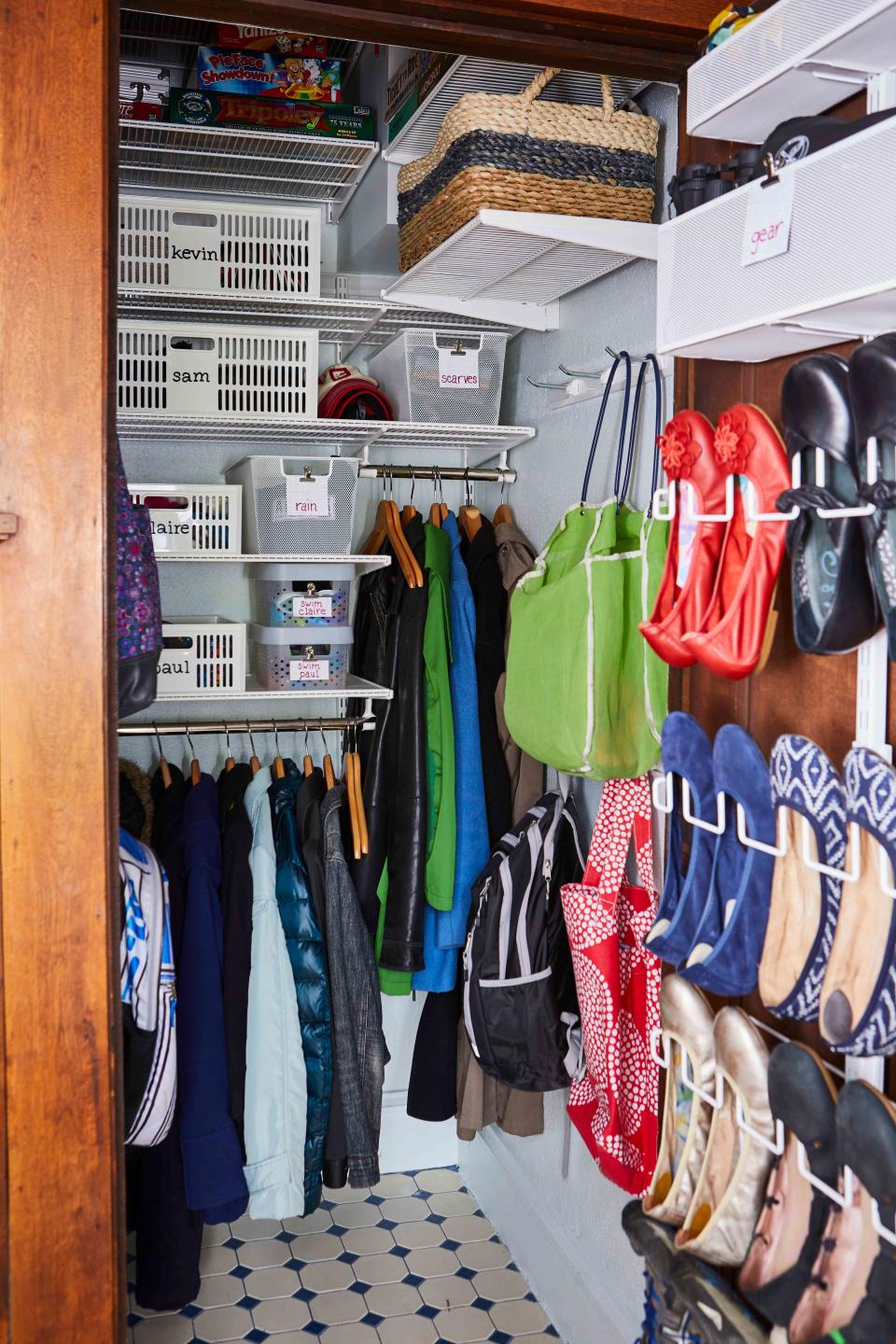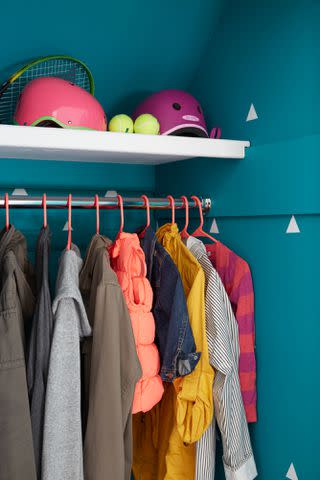How to Organize a Coat Closet
Keep a tidy coat closet year-round with this comprehensive organization plan.

Jason Donnelly
Most homes come equipped with a typical coat closet: One short rod, a single upper shelf, a bit of floor space, and a standard door that closes to hide everything stored inside. Because its contents are easily hidden, the coat closet often collects clutter. But there’s no reason to dread opening the door. We're sharing our best tips for coat closet organization so you can easily find what you need next time you're rushing out the door.
Whether it’s a coat, an umbrella, or your favorite sneakers, everything in your closet should be visible and easy to grab on busy mornings. Follow our step-by-step guide for simple coat closet organization so you can save time and stress.

Marty Baldwin
Declutter Your Coat Closet
Before diving into any home organizing project, everything in the space needs to be pulled out and sorted. You don’t want to waste time finding space for things you no longer need, want, or belong elsewhere, as is often the case in coat closets. Find a few hours on a weekend to do this and give yourself space to sort items. If there are multiple household members whose things are in the closet, make sure they’re around to make decisions as well.
Begin by making piles of different categories. Put all outerwear in one section (feel free to use a nearby couch or armchair to lay them down nicely), all footwear in another, and accessories in another. You can further separate items by family member or even by season. For example, winter hats, scarves, and gloves can be corralled together while summer hats, bags, and sunglasses can be placed in their own section. If you keep purses, backpacks, and pet supplies in the coat closet, put those aside as well.
As you’re sorting, pay attention to what you can declutter. Coats that are too small or no longer your style should be donated. If you have little ones, jackets that are in-between sizes (but still in good condition) can be packed away and labeled to be used as hand-me-downs later. Do the same with shoes, hats, and winter gear. Any items that shouldn’t be stored in the coat closet should go back to where they belong elsewhere in the house.
While the closet is totally empty, use the opportunity to thoroughly clean it. Vacuum the floor and wipe away any dust. Get scuff marks off the walls or, if you’re ambitious, give them a fresh paint job.
:
Create Zones in a Coat Closet
Once you’re left with only the items you’d like to keep in the coat closet, it’s time to carve out separate zones for everything. Remember, one of the best ways to get and stay organized is to store like items together. Of course, every home, closet, and personal preference is different but consider this a starting point for the basic coat closet sections:
Outerwear such as coats, jackets, vests, and cardigans
Shoes such as everyday sneakers, sandals, and boots
Accessories such as hats, gloves, and scarves
Daily essentials, including things you need to grab on your way out the door such as bags, umbrellas, sunglasses, and a lint-roller
Pet supplies such as leashes, travel water bottles, bags, and pet apparel

David A. Land
How to Organize Coats
Since the closet's main function is to store coats, start there. There are several ways to organize coats, so choose a method that works best for you.
Organize outerwear by type: Separate heavy down coats from lighter spring or fall jackets and vests. During warmer months, keep winter coats off to one side of the closet and swap them when it gets cold. If you’re struggling with a small space, consider putting off-season coats in storage. Be sure to wash the coats before putting them away for the season.
Organize outerwear by household members: Use closet divider labels to indicate where one person’s section ends and another starts.
Organize coats by length: If you have a decent amount of long items, keep them all to one side of the closet so you have more floor space for shoes.
Add a double hanging rod (especially if you have kids): Child-size jackets are much shorter than adult coats. By adding an adjustable double hanging rod, you gain more storage space. And by hanging kid items closer to the floor, little ones can reach their own winter gear without help.
Keep at least 15-20% of the rod open: Leave space for guests to hang their coats when they drop in during colder months. This will also help your items breathe better in the interim.
As you hang up coats, try to use all of the same hangers or at least similar ones. This won’t just make it look more organized, but it will also be easier to keep empty hangers tidy.
:

How to Organize Shoes and Boots
Only the shoes that you slip on and kick off regularly should be stored in a coat closet. Everything else should be stored elsewhere, ideally in a bedroom closet.
For sneakers, a single two-tier shoe rack on the floor works well. If there’s room on the rack, add boots as well. You can always use a boot tray to keep the floor clean from rain or snow boots, too. But if you lack space, consider keeping it outside the closet, perhaps in the garage during the cold and rainy seasons.
Flat shoes, such as flip-flops and slides, can be stored in an over-the-door shoe organizer if you don’t need the blank space for other items. Or consider placing them upright in a basket to save space. This is especially helpful for kids since their little shoes don’t always fit well on racks. Plus, it’s much easier for them to toss shoes into a bin, increasing the chances that they’ll actually put them away. You want to make it easy to grab or return shoes, so keep it simple.
:

Buff Strickland
How to Organize Accessories
If you don’t need an over-the-door organizer for shoes, use it for accessories! Most rolled-up scarves and winter beanies will fit perfectly in individual slots meant for shoes. So will umbrellas, bottles of sunscreen, lint rollers, sunglasses, and pairs of gloves. If you have larger accessories to store in a coat closet, like outdoor toys or bulky kids' items, cubby drawers are an easy way to stay organized without creating visual clutter.
These are some of the most efficient coat closet storage options for accessories:
Stackable, open front bins on a shelf: There’s usually a good amount of height in a closet, so you might be able to stack two or three storage bins. Out-of-season accessories can be placed in the bottom bins and swapped as needed. In lieu of stacking bins, consider adding an extra shelf for them instead. Slide a folding step stool in the closet to be able to reach whatever you need.
Hanging sweater cubby: If there’s room on the rod, loop one of these over and consider splurging for the drawer inserts to keep items from falling out.
Standing drawer unit: This works well if you have both a little floor and height space. You can get them as narrow or short as you need, so take careful measurements before purchasing. Assign and label one drawer per family member to stash their stuff.
Hooks: Everyday bags, totes, and backpacks can hang on S hooks on the rod, a rack on the back of the door, or individual ones on the inside wall. Consider a hanging scarf or hat organizer as well.
Customizable door rack: Baskets and pegboards with hooks can hold everything from your accessories to the dog’s supplies.
Wall-mounted file folders: If you keep mail and memos in the coat closet, attach vertical organizers with labels to the inside of the door. Don’t forget to go through it on a weekly, if not daily, basis.

